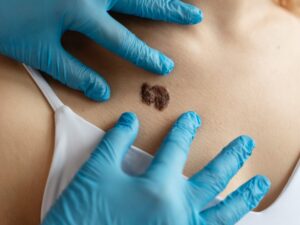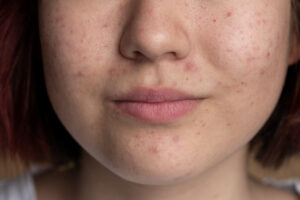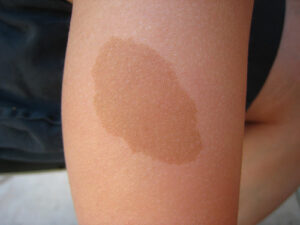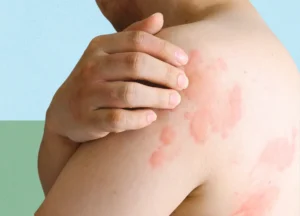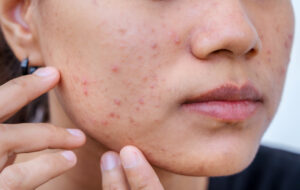Key Pointers
- Not all small bumps on the face are acne.
- Common causes include clogged pores, milia, fungal acne (Malassezia folliculitis), and seborrhoiec keratosis (plural keratoses).
- Some bumps may need professional assessment to confirm the diagnosis.
- A dermatologist can help identify the cause and advise on suitable management.
Noticing tiny bumps on your face can be worrying, especially if they don’t go away with your usual skincare routine. While many people assume these bumps are acne, there are actually several possible causes. Understanding the differences can help you know when it’s time to seek professional advice.
In this article, we break down some of the most common reasons for small facial bumps, ranging from simple clogged pores to conditions like milia or keratosis pilaris.
Acne and Clogged Pores
One of the most common causes of small bumps is acne, which develops when pores become clogged with oil, dead skin cells, and bacteria. These bumps may appear as:
- Whiteheads (closed comedones): small white bumps that stay under the skin.
- Blackheads (open comedones): small dark spots caused by clogged pores exposed to air.
- Papules and pustules: inflamed red bumps, sometimes with visible pus.
- Cysts and nodules: deeper, larger lumps under the skin that can be painful and may lead to scarring.
Acne can range from mild to severe, and it often fluctuates with factors like hormones, stress, and lifestyle. If over-the-counter treatments aren’t helping, a dermatologist can suggest medical options tailored to your skin.
Milia
Sometimes mistaken for whiteheads, milia are small, firm, pearly-white bumps. They form when keratin (a protein found in skin) becomes trapped under the skin’s surface. Unlike acne, milia are not due to bacteria or inflammation.
Milia commonly appear around the eyes, cheeks, or nose and can occur in both children and adults. They usually don’t cause discomfort, but they won’t go away easily with scrubs or creams. In many cases, a dermatologist can safely remove them if needed.
Fungal Acne (Malassezia Folliculitis)
Despite its name, fungal acne is not true acne. It is caused by an overgrowth of yeast (Malassezia) that normally lives on the skin. This condition leads to small, uniform, itchy bumps that often appear on the forehead, chest, or back, though the face can be affected too.
Fungal acne can look similar to regular acne, but it usually doesn’t respond to traditional acne treatments. In fact, some acne medications may worsen it. A dermatologist can distinguish between the two and recommend antifungal options if needed.
Seborrhoeic Keratoses
Seborrhoeic Keratoses are common, non-cancerous skin growths that can look like raised, waxy, or wart-like bumps. They may be light brown, dark brown, or even black, and can occur anywhere on the face or body.
Although harmless, seborrhoeic keratoses can sometimes be mistaken for other skin conditions, including skin cancer. They tend to appear with age and often increase in number over time. If you notice new or changing growths, it’s best to have them assessed by a dermatologist to rule out other causes.
Other Possible Causes
Small bumps on the face may also result from:
- Skin allergies or irritation – reaction to skincare, cosmetics, or environmental triggers.
- Rosacea – a chronic skin condition that can cause small red bumps along with visible blood vessels and flushing.
- Syringomas and other benign skin tumours – Syringomas are harmless sweat gland growths that often appear as multiple small, skin-coloured or slightly yellowish bumps, usually around the eyes. Other benign tumours, such as dermatofibromas or fibrous papules, may also appear as firm or raised bumps on the face. While these are non-cancerous, they can resemble other skin conditions, so a dermatologist’s evaluation is important for reassurance and accurate diagnosis.
- Viral warts – caused by the human papillomavirus (HPV), appearing as rough, raised bumps.
Because many of these conditions can look similar, self-diagnosis can be tricky.
When to See a Dermatologist
If your facial bumps are persistent, spreading, or causing discomfort, it’s best to seek professional advice. A dermatologist can:
- Examine the skin closely and identify the cause.
- Rule out less common but important conditions.
- Recommend appropriate treatment or procedures if needed.
Getting the right diagnosis ensures you don’t waste time on remedies that may not work, or that could make the problem worse.
Conclusion
Small bumps on the face can be frustrating, but they are not always acne. From clogged pores to milia or keratosis pilaris, there are many possible explanations. While some are harmless, others may require medical attention.
If you’re unsure what’s behind your skin changes, consulting a dermatologist is the best step towards clearer and healthier skin.
Book a Consultation with About Dermatology
At About Dermatology, we provide specialist care for skin conditions in adults and children. Led by Dr Melissa Tan, Senior Consultant Dermatologist, our clinic offers comprehensive medical, surgical, and laser dermatology services in a safe and professional setting.
- Conveniently located at Farrer Park Hospital
- Monday to Saturday (by appointment)
- Call us at 6518 4336 or book a consultation online


